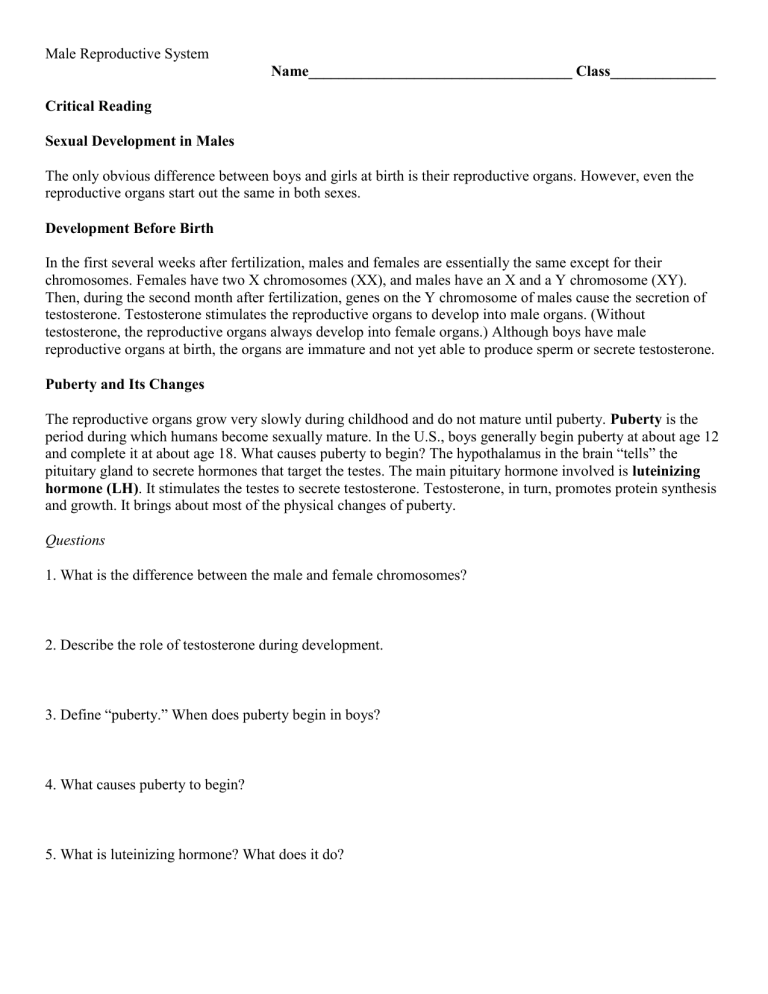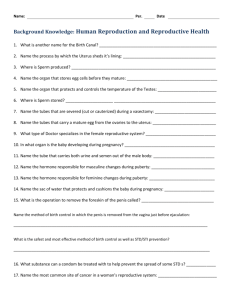2. produce sperm and secrete testosterone

Male Reproductive System
Name___________________________________ Class______________
Critical Reading
Sexual Development in Males
The only obvious difference between boys and girls at birth is their reproductive organs. However, even the reproductive organs start out the same in both sexes.
Development Before Birth
In the first several weeks after fertilization, males and females are essentially the same except for their chromosomes. Females have two X chromosomes (XX), and males have an X and a Y chromosome (XY).
Then, during the second month after fertilization, genes on the Y chromosome of males cause the secretion of testosterone. Testosterone stimulates the reproductive organs to develop into male organs. (Without testosterone, the reproductive organs always develop into female organs.) Although boys have male reproductive organs at birth, the organs are immature and not yet able to produce sperm or secrete testosterone.
Puberty and Its Changes
The reproductive organs grow very slowly during childhood and do not mature until puberty. Puberty is the period during which humans become sexually mature. In the U.S., boys generally begin puberty at about age 12 and complete it at about age 18. What causes puberty to begin? The hypothalamus in the brain “tells” the pituitary gland to secrete hormones that target the testes. The main pituitary hormone involved is luteinizing hormone (LH) . It stimulates the testes to secrete testosterone. Testosterone, in turn, promotes protein synthesis and growth. It brings about most of the physical changes of puberty.
Questions
1. What is the difference between the male and female chromosomes?
2. Describe the role of testosterone during development.
3. Define “puberty.” When does puberty begin in boys?
4. What causes puberty to begin?
5. What is luteinizing hormone? What does it do?
Male Reproductive System
True or False
_____ 1. A gamete is a haploid cell that combines with another haploid gamete during fertilization.
_____ 2. Each testis contains more than 90 meters of tiny, tightly packed tubules called seminiferous tubules.
_____ 3. Sperm mature and are stored in the epididymis.
_____ 4. In the first several weeks after fertilization, males and females are essentially the same.
_____ 5. Genes on the X chromosome cause male organ formation.
_____ 6. In the United States, boys generally begin puberty at about age 10 and complete it at about age 18.
_____ 7. Rapid growth occurs during puberty.
_____ 8. A sexually mature male produces hundreds of sperm each day.
_____ 9. Spermatogenesis takes between 9 and 10 weeks.
_____ 10. Sperm are produced in the epididymis and become mature in the seminiferous tubules.
_____ 11. When sperm “swim,” the tail rotates like a propeller.
_____ 12. Hundreds of billions of sperm are released with each ejaculation.
_____ 13. Spermatogenesis involves both mitosis and meiosis.
_____ 14. The part of the sperm called the tip produces enzymes that help the sperm penetrate an egg.
_____ 15. Spermatogonia lining the seminiferous tubule undergo meiosis to form primary spermatocytes.
1.
Which statement best describes a gamete?
1.
A gamete is a sex cell.
2.
A gamete is a cell involved in reproduction.
3.
A gamete is a haploid reproductive cell that combines with another haploid gamete during fertilization.
4.
Gametes combine during fertilization.
2.
Structures of the male reproductive system include which of the following? (1) the vas deferens, (2) the epididymis, (3) the fallopian tubes, (4) the seminiferous tubules.
1.
1 and 2
2.
1, 2, and 3
3.
1, 2, and 4
4.
1, 2, 3, and 4
3.
In boys, the adolescent growth spurt
1.
is controlled by testosterone.
2.
can be about 10 centimeters per year.
3.
rapidly continues for several years.
4.
all of the above
Male Reproductive System
4.
During spermatogenesis,
1.
sperm are produced in the seminiferous tubules of the testes and become mature in the epididymis.
2.
sperm are produced in the epididymis of the testes and become mature in the seminiferous tubules.
3.
sperm are produced in the vas deferens of the testes and become mature in the epididymis.
4.
sperm are produced in the vas deferens of the testes and become mature in the seminiferous tubules.
5.
Structures of a mature sperm cell include
1.
a tail.
2.
the mitochondrial segment.
3.
an acrosome.
4.
all of the above.
6.
What causes puberty to begin?
1.
The secretion of testosterone from the testes.
2.
The initial release of luteinizing hormone from the pituitary gland.
3.
New protein synthesis and growth.
4.
The development of testes.
7.
The epididymis
1.
is a very long coiled tube inside the scrotum.
2.
is where sperm mature.
3.
is where sperm are stored.
4.
all of the above
8.
How many sperm are released with each ejaculation?
1.
hundreds
2.
thousands
3.
millions
4.
hundreds of millions
Definitions
_____ 1. chemical messengers that control sexual development and reproduction
_____ 2. produce sperm and secrete testosterone
_____ 3. the period during which humans become sexually mature
_____ 4. the male sex hormone
_____ 5. the process of producing mature sperm
_____ 6. stimulates the testes to secrete testosterone
_____ 7. an external male genital organ
_____ 8. where sperm mature and are stored until they leave the body
_____ 9. rapid growth during puberty
_____ 10. consists of structures that produce gametes and secrete sex hormones
Male Reproductive System
_____ 11. process of releasing sperm
_____ 12. the fluid that carries sperm through the urethra
Terms a. adolescent growth spurt b. ejaculation c. epididymis e. penis f. puberty g. reproductive system i. sex hormones j. spermatogenesis k. testis d. luteinizing hormone
Fill in the blank h. semen l. testosterone
1. A ____________ is a haploid cell that combines with another haploid gamete during fertilization.
2. ____________ is the male sex hormone.
3. Each testis contains more than 30 meters of tiny, tightly packed ____________ tubules.
4. The ____________ is a coiled tube about 6 meters long lying atop the testis.
5. ____________ is the fluid that carries sperm through the urethra and out of the body.
6. The two sex chromosomes in males are ____________.
7. ____________ is the period during which humans become sexually mature.
8. ____________ are diploid, sperm-producing cells.
9. ____________ hormone stimulates the testes to secrete testosterone.
10. The process of producing mature sperm is called ____________.
11. After spermatids form, they mature in the ____________.
12. A sexually mature male produces hundreds of ____________ of sperm each day.
Critical Writing
Thoroughly answer the question below on your own paper. Use appropriate academic vocabulary and clear and complete sentences.
A mature sperm cell has several structures that help it reach and penetrate an egg. These structures include the tail, mitochondria, and acrosome. How does each structure contribute to the sperm’s function?






